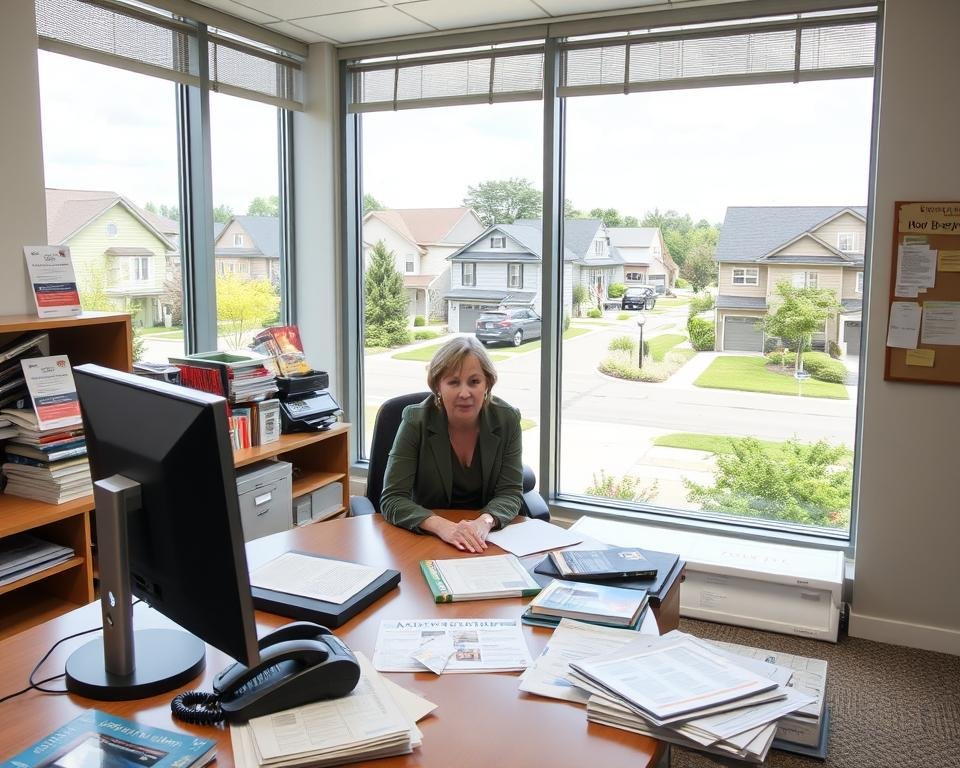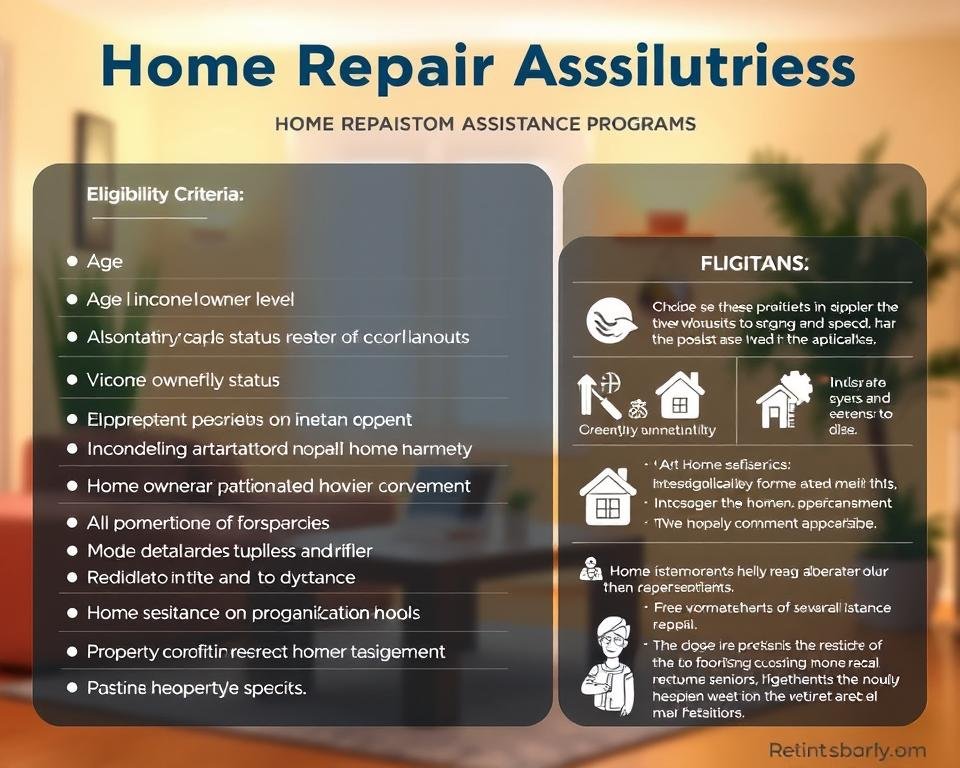“A comfortable house is a great source of happiness. It ranks immediately after health and a good conscience,” wrote Sydney Smith. For those entering retirement years, maintaining that comfort often requires smart planning and reliable resources.
This guide focuses on empowering you to preserve your independence through practical upgrades and tailored solutions. Whether adjusting doorways for easier access or updating lighting for better visibility, small changes can make big differences in daily living.
We’ll explore financial tools like federal repair grants and renovation loans that support your goals. While RenoFi doesn’t provide free grants, their specialized financing options help bridge gaps for larger projects. You’ll also discover community programs offering hands-on assistance with repairs and modifications.
Our goal? To help you create spaces that evolve with your needs – combining safety with personal style. Because your residence should remain a place of joy, not stress, as life’s chapters unfold.
Key Takeaways
- Aging in place requires strategic modifications to ensure safety and accessibility
- Federal programs and local initiatives offer financial support for essential upgrades
- Specialized renovation loans can fund larger projects when grants fall short
- Proactive maintenance prevents costly repairs and preserves property value
- Community organizations often provide hands-on assistance with minor repairs
- Lighting improvements and slip-resistant surfaces significantly reduce accident risks
Overview of Home Maintenance Assistance for Retired Seniors
Your residence becomes more than walls and windows as life progresses – it’s your sanctuary of independence. Physical limitations and fixed incomes often turn routine upkeep into complex puzzles. Leaky roofs, drafty windows, and outdated fixtures don’t just drain energy – they can erode confidence in living independently.
Navigating Repair Realities
Nearly 40% of older adults report at least one home improvement need impacting safety, according to AARP research. Common challenges include:
- Weather-related wear on roofs and foundations
- Outdated electrical systems needing upgrades
- Bathroom surfaces posing slip risks
The Support Landscape
Local assistance programs bridge gaps between needs and budgets. Many initiatives prioritize:
- Income-based eligibility for critical repairs
- Community partnerships offering volunteer labor
- Energy efficiency upgrades reducing long-term costs
State agencies often administer funds from federal sources like the Department of Housing. These resources help address urgent issues while preserving property value. Verification processes typically consider household size and total earnings – tools exist to make this step manageable.
Choosing to remain where memories reside isn’t just sentimental. Strategic modifications foster autonomy while reducing accident risks. From grab bars to wheelchair ramps, thoughtful changes let spaces adapt as needs evolve.
Understanding Home Repair Grants and Loans
Financial tools can unlock safer living spaces without draining savings. Let’s explore two pathways: grants that fund critical fixes and renovation loans that bridge budget gaps for larger projects.
What Are Home Repair Grants?
Grants act like financial gifts for essential repairs. The USDA’s Single Family Housing program offers up to $10,000 for rural residents aged 62+, targeting safety upgrades like roof replacements or wheelchair ramps. “These funds transform houses into secure havens,” notes a HUD spokesperson. Unlike loans, grants never require repayment – but often come with strict income limits and geographic restrictions.
The Role of Renovation Loans
When grants don’t cover your needs, specialized financing steps in. RenoFi’s unique model bases loan amounts on your property’s post-renovation value, often providing 75% more funds than traditional options. Urban dwellers might prefer HUD’s 203(k) loans, which bundle repair costs into mortgage refinancing.
Key differences to consider:
- Grants prioritize urgent safety fixes
- Loans enable comprehensive remodels
- Location impacts eligibility (rural vs. urban)
Your area’s resources shape what’s possible. Coastal communities might offer storm-proofing incentives, while mountain regions could focus on heating system upgrades. Always compare program requirements – some need proof of ownership, others require contractor bids. By matching solutions to your specific situation, you create lasting comfort on your terms.
Essential Home Maintenance Help for Retired Seniors
Your living space thrives on attention to detail – especially as needs evolve over time. Common fixes like patching leaky pipes or replacing worn caulking prevent water damage and mold growth. Outdated electrical systems rank high on priority lists, with many older properties lacking GFCI outlets near water sources.
- Test smoke detectors monthly and replace batteries annually
- Clean gutters every spring and fall to prevent roof leaks
- Apply non-slip coatings to bathroom floors and shower stalls
Schedule annual checks for heating systems and plumbing. Early detection of furnace issues or pipe corrosion avoids winter emergencies. A licensed inspector can spot hidden risks like loose handrails or uneven walkways during these visits.
Minor upgrades create compounding benefits. Weatherstripping doors cuts energy bills while reducing drafts. Motion-activated lighting in hallways improves visibility without fumbling for switches. These adjustments work together to enhance daily comfort and prevent accidents.
Local agencies often provide free safety assessments or discounted repair services. Partnering with certified contractors ensures modifications meet current building codes. Remember: small investments today preserve independence tomorrow.
Federal Programs and Their Offerings
Navigating federal assistance options can unlock crucial support for property upgrades. Government-backed initiatives provide structured pathways to address essential repairs while managing costs effectively.

USDA Single Family Housing Repair Grants
The USDA offers grants up to $10,000 for rural residents aged 62+ with limited income. To qualify, your household must:
- Own and occupy the property as primary residence
- Meet specific income thresholds (typically below 50% of area median)
- Need safety-related improvements like roof repairs or accessibility features
Funds can cover materials and labor, with additional low-interest loans available for larger projects. Documentation requirements include proof of ownership, income verification, and contractor estimates.
HUD and 203(k) Rehabilitation Programs
Urban dwellers benefit from HUD’s 203(k) rehabilitation mortgage insurance. This program lets you:
- Combine renovation costs with mortgage refinancing
- Address structural issues and modernize systems
- Access up to $35,000 for energy-efficient upgrades
Approval depends on creditworthiness and property location. Required paperwork includes contractor bids, architectural plans, and proof of insurance. “The 203(k) program turns fixer-uppers into safe, modern dwellings,” explains a HUD housing counselor.
Many homeowners in eligible areas have transformed properties using these programs. A Kansas family recently used USDA funds to install wheelchair ramps and storm-resistant windows. Always check local agency websites for application deadlines and regional variations.
Community and Nonprofit Support for Home Repairs
Neighbors helping neighbors isn’t just a saying – it’s a powerful force shaping living spaces across America. Beyond government programs, grassroots efforts fill critical gaps through hands-on work and creative partnerships.
National Networks Making an Impact
Rebuilding Together’s Safe at Home initiative completes over 10,000 projects yearly. Volunteers install grab bars, fix uneven flooring, and replace broken windows at no cost. “Our work keeps people safe where they feel most comfortable,” shares their CEO.
Habitat for Humanity’s Aging in Place program focuses on accessibility. Recent projects include:
- Widening doorways for wheelchair access in Ohio homes
- Installing walk-in showers with built-in seating in Texas
- Creating zero-step entries for Maryland residents
Local Solutions With Lasting Results
Churches and civic groups often organize repair blitzes. The Minneapolis Block Project upgraded 27 houses last fall with energy-efficient windows and secure railings. These efforts frequently partner with county agencies to maximize resources.
Many organizations offer sliding-scale fees based on income. Some coordinate with housing options to create comprehensive support networks. Check community boards or area agencies on aging to find nearby programs.
A St. Louis couple recently received free roof repairs through a local coalition. Their story shows how community connections can transform houses into secure, functional homes. By tapping into these networks, you gain allies committed to preserving your independence.
Eligibility and Qualification Tips for Home Repair Assistance
Understanding program requirements opens doors to safer living environments. Most assistance programs follow three core benchmarks: age thresholds, income limits, and property ownership status. Meeting these criteria ensures your application receives proper consideration.

Income, Age, and Home Ownership Criteria
Typical qualifications for home repair grants include being 62+ years old with household earnings below 50% of your area’s median income. The USDA’s rural program requires proof of ownership through deeds or tax records. HUD-backed options often need recent pay stubs or Social Security statements.
Key documents to prepare:
- Two years of tax returns
- Mortgage statements or property deeds
- Contractor cost estimates for proposed work
Special Considerations for Veterans and Disabled Seniors
Former service members access unique benefits through VA modification grants up to $6,800. Disabled residents may qualify for USDA’s $10,000 grants without age restrictions if needing wheelchair ramps or bathroom overhauls. These programs prioritize safety upgrades over cosmetic changes.
Practical preparation steps:
- Organize medical documentation for disability claims
- Request veteran status verification through eBenefits
- Compare multiple contractor bids for accuracy
By aligning your situation with program specifics, you increase approval chances significantly. A Baltimore couple recently secured roof repairs by presenting clear income documentation and prioritized safety needs. Remember: Complete applications move faster through review processes.
Comparing Grants, Loans, and Other Financial Options
Choosing the right financial path requires understanding how different solutions align with your goals. Grants provide immediate relief for urgent fixes, while loans unlock possibilities for comprehensive upgrades. Let’s break down what each option offers.
Grants shine when addressing safety-critical needs. Programs like USDA’s rural initiative cover essential repairs without repayment obligations. However, strict income limits and geographic restrictions apply. “These funds work best for single-focus projects,” explains a HUD advisor, “like fixing a leaky roof or installing grab bars.”
Renovation loans offer greater flexibility for multi-phase projects. RenoFi’s unique approach calculates borrowing power using your property’s future value after improvements – often allowing 75% more funding than traditional options. This model works well for combining accessibility features with energy-efficient upgrades.
Key considerations when evaluating options:
- Grants average $7,500 vs. loans up to $100,000+
- No repayment vs. 10-30 year terms
- 3-6 month approval timelines for both
Prioritize repairs based on funding type. Use grants for urgent safety issues and loans for value-boosting improvements. A recent case saw a Pennsylvania couple use RenoFi financing to remodel their kitchen and bathroom simultaneously, increasing their property’s functionality and resale potential.
Assess your timeline, income stability, and project scope. Quick fixes often suit grant programs, while phased renovations benefit from loan structures. Consult local housing counselors to explore hybrid approaches – some combine grant funds with low-interest loans for optimal results.
Step-by-Step Guide to Applying for Assistance
Successfully obtaining aid for essential fixes starts with understanding the steps involved. A clear roadmap helps avoid delays and increases approval odds. Let’s break down the process into manageable phases.

Gathering Required Documentation
Start by collecting proof of ownership like property deeds or tax records. Income verification typically requires:
- Recent pay stubs or Social Security statements
- Two years of tax returns
- Bank account summaries
Programs like USDA grants need contractor estimates for proposed work. Keep digital and physical copies organized in labeled folders.
Completing and Submitting Your Application
Double-check form entries against your documents. Common errors include mismatched addresses or outdated income figures. For HUD’s 203(k) program, include architectural plans and insurance proof.
Follow these tips:
- Submit 30+ days before deadlines
- Use certified mail for paper applications
- Confirm receipt via phone or email
Many homeowners find success using online portals for faster processing. If grants don’t cover your needs, explore specialized financing options that consider post-renovation property value.
Set calendar reminders to follow up weekly. A Pennsylvania couple secured roof repairs by persistently contacting their local housing agency. Remember: organized applicants move through approval pipelines fastest.
Improving Home Safety and Accessibility
Creating a secure living environment starts with smart upgrades that serve multiple purposes. Addressing existing risks while planning for future needs ensures spaces remain comfortable and functional for years.
Essential Repairs to Enhance Security
Three critical fixes prevent common accidents:
- Sealing leaky roofs to avoid water damage
- Updating faulty wiring that could spark fires
- Applying textured coatings to slippery floors
Groups like Rebuilding Together often provide free installation services for these repairs. A Chicago resident recently had their entire bathroom retrofitted with slip-resistant tiles through such programs.
Smart Upgrades for Easier Living
Strategic changes create welcoming spaces for all abilities. Consider adding:
- Grab bars near showers and toilets
- Ramps with non-skid surfaces
- Energy-efficient LED lighting
These modifications reduce fall risks while cutting energy costs. Programmable thermostats and insulated windows maintain comfort year-round. Many properties see value increases after such upgrades – a win for safety and resale potential.
Local agencies frequently partner with contractors to complete these improvements at reduced rates. By focusing on dual-purpose changes, you create spaces that protect independence while keeping utility bills manageable.
Local Government and Community-Based Programs
Your neighborhood holds hidden resources for creating safer living spaces. Local programs often provide targeted solutions that complement federal initiatives. Start by visiting county housing authority websites – these platforms list assistance options tailored to your area’s needs.
Finding Programs in Your Community
State housing departments manage funds from national sources like HUD. California’s CalHome program offers grants for accessibility upgrades, while Texas’ Community Development Block Grants fund roof repairs. These organizations offer:
- Free safety inspections through partnerships with licensed contractors
- Sliding-scale fees based on household income
- Priority services for mobility-related modifications
Nonprofit networks like Rebuilding Together coordinate volunteer teams for critical fixes. In Ohio, their crews recently installed energy-efficient windows and repaired porches for 40 households. Check community center bulletin boards or Area Agencies on Aging for local opportunities.
Combine federal support with community resources for maximum impact. A Florida resident secured HVAC repairs through state funds while volunteers from Habitat for Humanity updated their bathroom. Contact housing counselors at 211.org for personalized guidance – they can map available options to your specific situation.
Explore multiple channels to uncover all possibilities. Many programs update their offerings seasonally, with winterization assistance becoming available each fall. Remember: layered support systems often yield the best results for lasting comfort.
Conclusion
Your living environment shapes daily experiences while protecting independence. Addressing repair needs combines practical action with smart financing choices – whether through grants for urgent fixes or renovation loans for larger upgrades. Remember: eliminating safety hazards often costs less than accident-related expenses.
Explore all options before committing. Federal programs and local organizations frequently work together to maximize support. While free home repair grants solve immediate issues, specialized financing bridges gaps for comprehensive changes.
Proactive measures preserve both property value and peace of mind. Simple upgrades like securing handrails or improving lighting create cascading benefits. Every adjustment moves you closer to spaces that adapt as needs evolve.
Ready to transform your residence? Start by contacting area housing agencies or visiting trusted online resources. Your next step toward safer, more comfortable living begins today.
